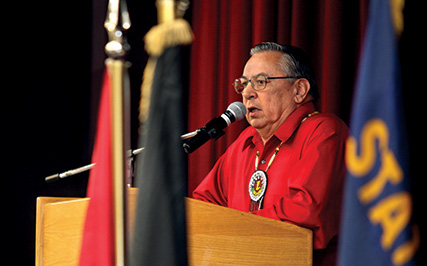Tribal Government & News
Tribe hosts Indian Child Welfare Act Conference

The 2013 Indian Child Welfare Act conference, "Strengthening
Families, Strengthening Nations," aimed at bringing best practices
to Tribal child welfare workers who represented all nine of
Oregon's federally recognized Tribes and the Smith River Tribe in
California.
Those workers met in Grand Ronde for three days of lectures,
discussions and sharing of personal experiences from Oct. 22-24.
Some 250 filled the Tribal gym where they heard from Indian Child
Welfare specialists across Oregon and from Grand Ronde Land and
Culture staff.
They heard about best practices in such subjects as moving past
historical trauma; vision, courage and spirit values; the
importance of knowing who you are; prevention services for youth;
suicide prevention; and the value of collaboration.
One statistic that makes Tribal family issues so important, said
Lois Day, Tribal Affairs director for the Oregon Department of
Human Services, is that Native children are overrepresented among
families where state and Tribal welfare workers are forced to
intervene.
Successful outcomes, said Dana Ainam, supervisor of Grand Ronde's
Children and Family Services program, come when Tribes partner with
state, public and private groups.
The conference was co-sponsored by the Grand Ronde Tribe and the
state Department of Human Services.
Another successful strategy, said Human Services Director Erinn
Kelley-Siel, "is having an appreciation for similarities and a
respect for differences." Three other keys for success are
vigilance, resources and advocacy, she said.
In regard to resources, she praised a statewide legislative
initiative that gives child welfare programs $100 million in the
state's biennial budget. "People don't invest in programs that are
not working," she said.
Recommendations for a study for Gov. John Kitzhaber included a
policy that addresses the differences among communities. "We want
to make services real for everybody, not just the majority,"
Kelley-Siel said.
There is now a shift, she said, from an intervention model to a
prevention model.
In that regard, Chris Martin, an Indian Child Welfare worker in the
Tribe's Social Services Department, described his experiences with
the Tribe's family and child welfare program.
He went from a 10-year battle with poverty, addiction and the loss
of his children to foster families to recovery and his current
position with the Tribe.
"I relapsed pretty hard" within a week after the court allowed
unification with his children, who returned home for the first time
in 1999, Martin said.
"I totally blew it," he said.
"Now, relapse is a common part of recovery," said Kristi Petite,
the Tribe's Child and Family Services lead case worker, who
participated in Martin's case from the beginning. She watched his
successes and failures, and when he was back on track, she brought
him on board as a Tribal caseworker.
"I never gave up," Martin said.
"The Tribe and the state worked together on this case from day
one," said Petite.
Tina Lara, Youth Prevention activity assistant, participated in
youth panels, describing connections to the community, culture and
youth prevention activities.
Tribal Historian David Lewis, with slides, described the floor plan
for Tribe's Chachalu Grand Ronde Tribal Museum and Cultural Center.
He also described current and historical Tribal cultural
activities.
Land and Culture Manager Jan Looking Wolf Reibach spoke about "the
importance of connecting youth with their culture" and said the
Tribe is "formulating a strategy to get our lands back."
Tribal Council member Jon A. George gave the invocation on the
first day and later added his personal experiences with family and
children services over the years.
In addition, George described the traumas that Tribal people have
suffered, and that raised the question, "How can we heal our
people, culturally and historically?"
In answer, he described a new sacred Atudship site adjacent to the
Tribal Cemetery. "Historically, we are stone builders," he said. At
the site, those in need will place stones on a mound for healing
and forgiveness. The 30th anniversary of Restoration, coming Nov.
22, is a significant time to use the mound and the stones, he
added.
Tribal drummers and an honor guard with veterans from many Tribes
opened the conference.
Tribal Council Chair Reyn Leno welcomed the group.
"People don't realize who we are," Leno said. "They think we're the
casino, but when we drive by the casino we think of the programs we
support."
The Tribe has made a significant financial commitment to Tribal
child welfare, Leno said. "At the end of the day, it's what's best
for our kids."
